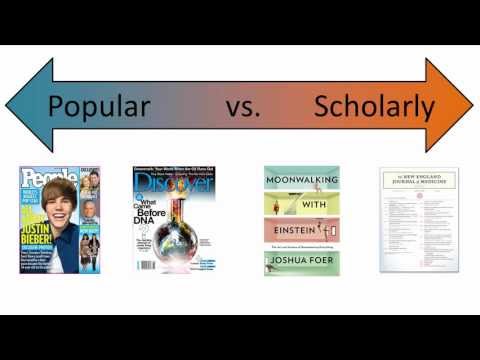8.3: Types of Sources- Primary, Secondary, Tertiary
- Page ID
- 20067
For a review of what popular sources are, see Section 2.4
For a review of what academic sources are, see Section 2.5
In earlier chapters, you learned about what the differences are between popular and scholarly sources. If you are still unsure about the difference between those types of sources, here is a quick and useful reference:
The determination of a text as “popular” or “scholarly/academic” is one way to classify it and to understand what type of information you are engaging with. Another way to classify sources is by considering whether they are primary, secondary or tertiary. Popular sources can be primary, secondary, or tertiary. Scholarly sources, also, can be primary, secondary, or tertiary.
What is a Primary Source?
Primary sources are texts that arise directly from a particular event or time period. They may be letters, speeches, works of art, works of literature, diaries, direct personal observations, newspaper articles that offer direct observations of current events, survey responses, tweets, other social media posts, original scholarly research (meaning research that the author or authors conduct themselves) or any other content that comes out of direct involvement with an event or a research study.
Primary research is information that has not yet been critiqued, interpreted or analyzed by a second (or third, etc) party.
Primary sources can be popular (if published in newspapers, magazines or websites for the general public) or academic (if written by scholars and published in scholarly journals).
Examples of primary sources:
- journals, diaries
- blog posts
- a speech
- data from surveys or polls
- scholarly journal articles in which the author(s) discuss the methods and results from their own original research/experiments
- photos, videos, sound recordings
- interviews or transcripts
- poems, paintings, sculptures, songs or other works of art
- government documents (such as reports of legislative sessions, laws or court decisions, financial or economic reports, and more)
What is a Secondary Source?
Secondary sources summarize, interpret, critique, analyze, or offer commentary on primary sources.
In a secondary source, an author’s subject is not necessarily something that he or she directly experienced. The author of a secondary source may be summarizing, interpreting or analyzing data or information from someone else’s research or offering an interpretation or opinion on current events. Thus, the secondary source is one step away from that original, primary topic/subject/research study.
Secondary sources can be popular (if published in newspapers, magazines or websites for the general public) or academic (if written by scholars and published in scholarly journals).
Examples of secondary sources:
- book, movie or art reviews
- summaries of the findings from other people’s research
- interpretations or analyses of primary source materials or other people’s research
- histories or biographies
- political commentary
What is a Tertiary Source?
Tertiary sources are syntheses of primary and secondary sources. The person/people who compose a tertiary text are summarizing, compiling, and/or paraphrasing others’ work. These sources sometimes do not list an author.
Tertiary sources can be popular or academic.
Examples of tertiary sources include:
- encyclopedias
- fact books
- dictionaries
- guides
- handbooks
- Wikipedia
Thinking about Primary, Secondary and Tertiary Sources and your Research Strategy
- What kinds of primary sources would be useful for your research project? Why? Where will you find them? Are you more interested in popular primary sources or scholarly primary sources — and why?
- What kinds of secondary sources could be useful for your project – and why? Are you more interested in popular secondary sources or scholarly secondary sources – and why?
- What kinds of tertiary sources might you try to access? In what ways would this tertiary source help you in your research?



